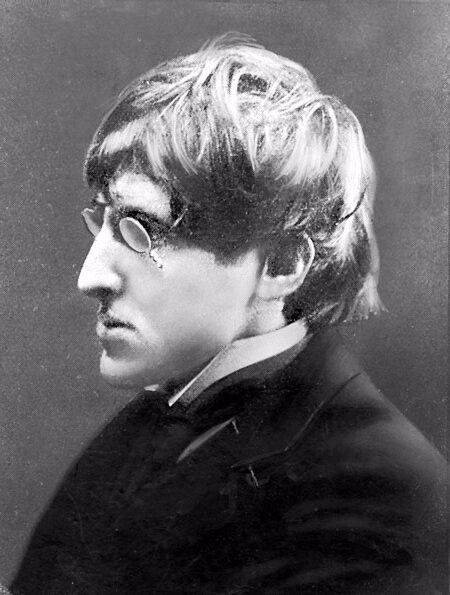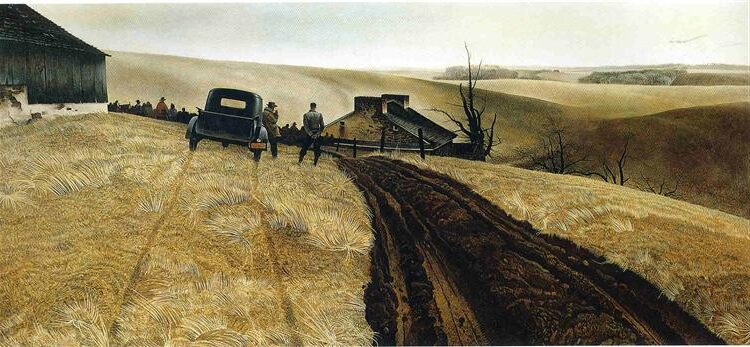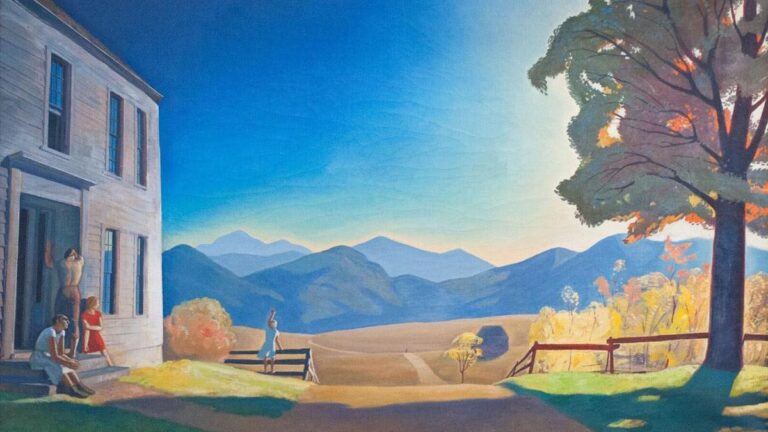Nikolai Astrup Painter: Norway’s Visionary Landscape Artist (1880-1928)
Born: August 30, 1880, Kalvåg, Bremanger, Norway
Death: January 21, 1928,Førde, Sogn og Fjordane, Norway
Art Movement: Neo-Romanticism
Nationality: Norwegian
Teachers: Christian Krohg and Lovis Corinth
Institution: Harriet Backer’s Painting school, Académie Julian, Académie Colarossi, Arthur Lewin-Funcke’s school of Painting
Nikolai Astrup Painter: Norway’s Visionary Landscape Artist (1880-1928)
Life and Career of Nikolai Astrup
Nikolai Astrup (1880-1928) combined modernist techniques with deep connections to Norwegian landscapes and traditions. His journey from a pastor’s son to an acclaimed artist reveals his determination to pursue art despite family opposition.
Early Years and Education
Born in Bremanger, Norway, Nikolai Astrup was the first of fourteen children in a strict Lutheran family. His father was a pietistic pastor who strongly opposed his artistic ambitions. Despite this resistance, Astrup pursued his passion for art.

Fjøsfrieri, 1902 by Nikolai Astrup
At nineteen, he moved to Kristiania (now Oslo) to study under prominent Norwegian artist Christian Krohg. This formal training laid the foundation for his technical skills.
From Oslo, Astrup continued his education in Paris, studying at prestigious institutions including Académie Julian and Académie Colarossi. These schools exposed him to contemporary European artistic movements that would influence his later work.
Influence of European Art
During his time abroad, Astrup encountered various artistic styles that shaped his development. He traveled through Berlin, Dresden, and Hamburg, absorbing different approaches to color and composition.
The works of Henri Rousseau and Arnold Böcklin particularly impressed him. Rousseau’s naive style and Böcklin’s mythical landscapes resonated with Astrup’s own interest in folklore and natural scenery.
Unlike many contemporaries who embraced bohemian lifestyles, Astrup maintained a certain distance from artistic social circles. He absorbed technical and stylistic innovations but remained committed to developing his own unique visual language.
His European education gave him sophisticated tools to express his deeply personal connection to Norwegian landscapes.
Return to Jølster and Artistic Maturation
In 1902, Astrup returned to his childhood region of Jølster in western Norway. This homecoming marked a crucial turning point in his career.

Kjerringa med lykta by Nikolai Astrup
The dramatic landscapes around Ålhus became his primary subject matter. He painted the lush valleys, reflective lakes, and distinctive mountains with vibrant colors and strong emotional resonance.
Astrup’s work from this period shows his intense use of color to capture the unique quality of Norwegian light. He developed a highly personal style that combined detailed observation with emotional and symbolic elements.
Unlike many Norwegian artists who romanticized rural life, Astrup portrayed traditional farming communities with both reverence and clear-eyed realism.
Family Life and Personal Struggles
In Jølster, Astrup established a home called Astruptunet. He married and raised a family while continuing to develop as an artist despite financial difficulties.
His health posed significant challenges throughout his life. Persistent respiratory problems, eventually diagnosed as pneumonia, limited his physical activities and travel opportunities.
Despite these constraints, Astrup maintained a disciplined artistic practice. He worked in both painting and woodcuts, creating richly detailed images of his surroundings in Kalvåg and surrounding areas.
Astrup’s deep connection to local traditions and folklore informed his work. He documented traditional practices and celebrations, preserving cultural heritage through his art. He died in 1928 at the age of 47, leaving behind a distinctive body of work that would later secure his place in Norwegian art history.
Artistic Style and Themes

Vårkveld ved Jølstervannet, 1900 by Nikolai Astrup
Nikolai Astrup developed a distinctive artistic vision that captured the essence of Norwegian landscapes and rural life. His work combined technical innovation with deep emotional connections to his homeland, creating a unique place in Norwegian art history.
Landscape and Nature
Astrup’s paintings and woodcuts portrayed the dramatic landscapes of western Norway, particularly the Jølster region in Nordfjord where he spent most of his life. Unlike his contemporary Edvard Munch who explored psychological themes, Astrup focused on the physical connection between humans and nature.
His distinctive depictions of mountains, lakes, and gardens show a deeply personal relationship with the land. Astrup often painted the same scenes repeatedly in different seasons and lighting conditions, creating an intimate visual record of his surroundings.
The willow tree appears frequently in his work as a distinctive motif, sometimes resembling human forms. This blend of reality and slight mysticism gives his landscape art a dreamlike quality while maintaining strong ties to the physical world.
Seasonal Changes and Rural Life
Seasonal shifts play a crucial role in Astrup’s artistic vision. He meticulously documented how Norwegian rural life adapted to the cycle of seasons – from spring planting to summer harvests, autumn preparations and winter endurance.
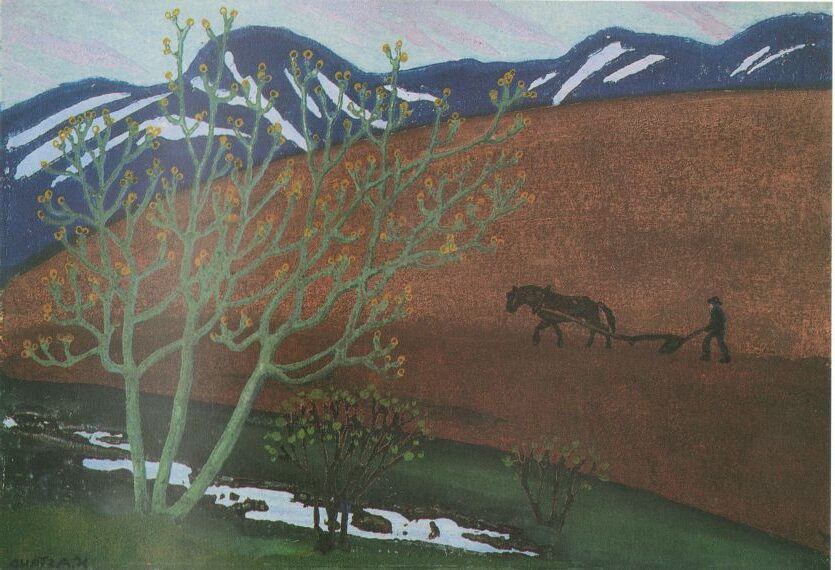
Plognatten by Nikolai Astrup
His paintings of farm work and rural traditions showcase the Norwegian peasant experience with dignity and warmth. Scenes of traditional celebrations, particularly midsummer bonfires, appear throughout his works.
Astrup’s garden paintings reveal both beauty and the challenge of cultivating life in harsh conditions. His images of peasant girls and farmers engaged in daily tasks celebrate Norwegian identity and rural traditions without romanticizing their hardships.
The artist’s connection to place gives his seasonal paintings a quality that feels both timeless and specific to Norwegian cultural heritage.
Technique and Medium
Astrup worked in both painting and woodcut printmaking, developing innovative approaches to both. His painterly style featured bold lines and rich colors that captured the distinctive quality of Norwegian light.
His approach to woodcuts was revolutionary. Unlike traditional prints with clear lines, Astrup developed a technique creating painterly woodcuts with textured surfaces and vibrant colors. After seeing Japanese ukiyo-e prints in 1909, he adapted these influences into his unique graphic technique.
Astrup carved multiple blocks for different colors, sometimes reworking the blocks between printings. This labor-intensive process created prints with remarkable depth and texture.
His technical innovations place him as a neo-romantic painter with connections to artists like John Constable, yet his work remains distinctly Norwegian. Modern critics recognize how his techniques anticipated developments in contemporary art while staying rooted in tradition.
Legacy and Influence
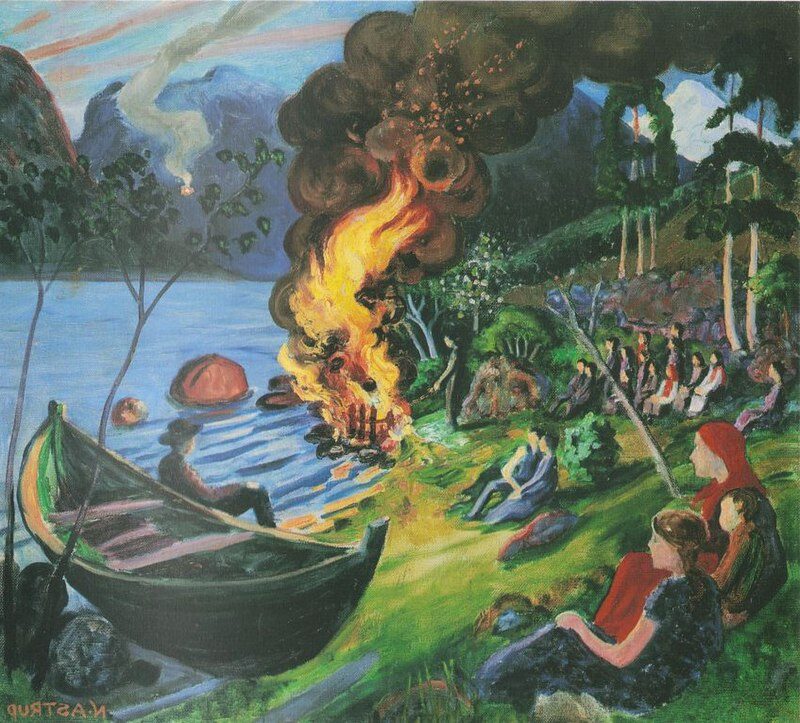
St. Hansbål ved Jølstervatnet, 1909 by Nikolai Astrup
Nikolai Astrup’s artistic contributions have gained increasing recognition both in Norway and internationally. His unique vision of the Norwegian landscape and cultural traditions continues to resonate with audiences and influence artists today.
Recognition and Exhibitions
Astrup’s work remained relatively unknown outside Norway for many years after his death in 1928. This changed dramatically in 2016 when the Dulwich Picture Gallery in London held the first major exhibition of his work outside Norway.
The exhibition introduced Astrup to international audiences as a neo-romantic painter with a distinctive style. His works have since been featured at prestigious venues including the Royal Academy of Design.
In Norway, Astrup has long been celebrated as a national treasure. His former home in Jølster (now Sunnfjord) has been preserved as a museum, allowing visitors to experience the landscapes that inspired his art.
Impact on Norwegian and International Art
Astrup’s influence extends beyond his lifetime, particularly in how he captured the essence of Norwegian identity through landscape. Unlike his contemporary Edvard Munch, Astrup developed his style away from European art centers.
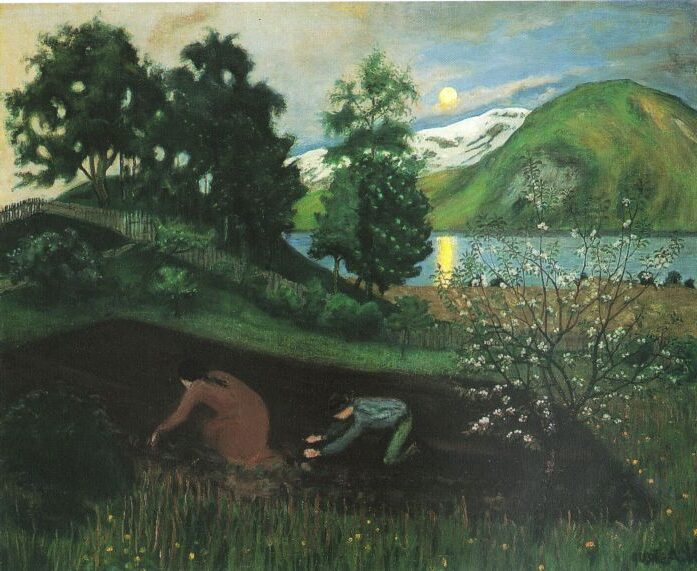
Vårnatt i hagen, 1909 by Nikolai Astrup
After studying briefly at the Académie Colarossi in Paris and under artists like Lovis Corinth and Arthur Lewin-Funcke in Berlin, Astrup rejected urban influences. Instead, he created a highly personal visual language rooted in local traditions.
His innovative printmaking techniques and bold use of color influenced later generations of Norwegian artists. Contemporary art in Norway still shows traces of Astrup’s approach to landscape as both physical reality and emotional experience.
Many modern artists draw inspiration from how Astrup’s gardens and landscapes blur the line between the observed and the imagined, creating works that are both documentary and deeply personal.
Frequently Asked Questions
Nikolai Astrup’s work and life inspire many questions from art enthusiasts and scholars alike. His unique vision of Norwegian landscapes and cultural elements continues to fascinate viewers around the world.
What are the notable themes and subjects in Nikolai Astrup’s artwork?
Astrup’s artwork predominantly features the western Norwegian landscape, particularly the area around Jølster where he spent most of his life. He painted lush, vibrant scenes of mountains reflected in lakes and fjords.
Spring and midsummer celebrations appear frequently in his work, including bonfires that symbolize traditional Norwegian customs. These festive scenes often blend reality with folklore elements.
Gardens and cultivated land serve as important subjects, reflecting Astrup’s deep interest in horticulture. He meticulously depicted local plants, farmsteads, and the changing seasons of rural Norway.
How did the Western Norway landscape influence Astrup’s painting style?
The dramatic terrain of Western Norway shaped Astrup’s distinctive perspective and color palette. He developed a highly personal style that captured the region’s unique light qualities and atmospheric conditions.
Astrup painted the same motifs repeatedly in different seasons and lighting, showing his deep connection to place. His intimate knowledge of local geography allowed him to portray subtle nuances in the landscape that outsiders might miss.
The steep mountains, reflective lakes, and lush vegetation of Jølster became characters in his visual narratives. This immersive relationship with the landscape resulted in paintings that feel both observed and dreamed.
Can you list significant exhibitions that have featured Nikolai Astrup’s work?
A major retrospective at the Dulwich Picture Gallery in London (2016) marked Astrup’s first significant exhibition outside Norway. This show introduced his work to a broader international audience.
The Clark Art Institute in Massachusetts hosted “Nikolai Astrup: Visions of Norway” in 2021. This exhibition helped establish his reputation in North America.
In Norway, the KODE Art Museums in Bergen maintain the largest collection of his works. They regularly feature Astrup in their exhibition program, celebrating his importance to Norwegian art.
What is the historical and cultural significance of Nikolai Astrup in Norwegian art history?
Astrup emerged during a crucial period of Norwegian national identity formation after the country’s independence from Sweden in 1905. His focus on distinctly Norwegian landscapes and traditions aligned with cultural nationalism of the era.
Unlike contemporaries who studied extensively abroad, Astrup developed a more isolated and personal artistic vision. This independence from international art movements resulted in highly original work that stands apart from other Norwegian painters.
Astrup’s art serves as an important visual document of rural Norwegian life and traditions in the early 20th century. His depictions of local customs and landscapes preserve cultural memories that might otherwise have been lost.
How do Nikolai Astrup’s techniques and materials distinguish his work from his contemporaries?
Astrup developed innovative woodcut techniques that combined multiple blocks with hand-coloring. This approach produced prints with exceptional depth and textural qualities unlike those of other printmakers of his time.
His painting technique featured bold, simplified forms and vibrant colors that created an almost supernatural quality. This distinctive style makes his work immediately recognizable compared to more naturalistic contemporary painters.
Astrup often repurposed canvases and worked on both sides of paper to maximize limited materials. This practical approach sometimes resulted in unexpected textures and effects that became characteristic of his work.
What is the legacy of Nikolai Astrup’s contributions to the development of national identity through art in Norway?
Astrup helped define a visual language of Norwegian identity based on rural landscapes and traditions. His images of midsummer bonfires and mountain farms became emblematic of Norwegian cultural heritage.
His artistic isolation paradoxically made his work more authentic and significant to national identity. By focusing intensely on his immediate surroundings rather than international trends, he captured something essentially Norwegian.
Recent international exhibitions have broadened appreciation for Astrup beyond Norway. Art historians now recognize his contribution to early modernism. They also recognize his unique position between tradition and innovation in European art.


